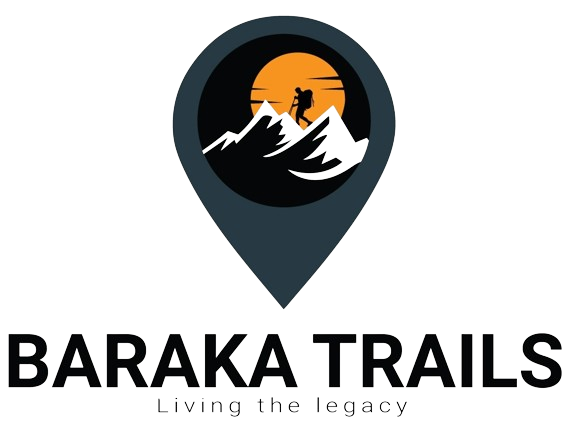8 Days Lemosho Route
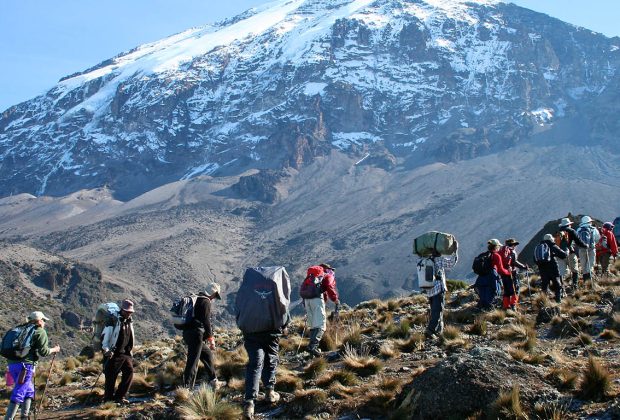
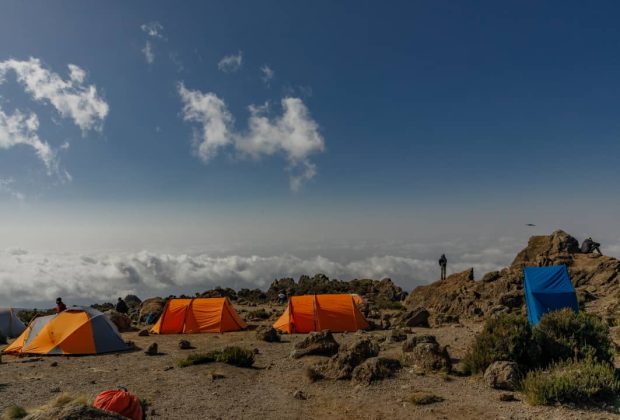
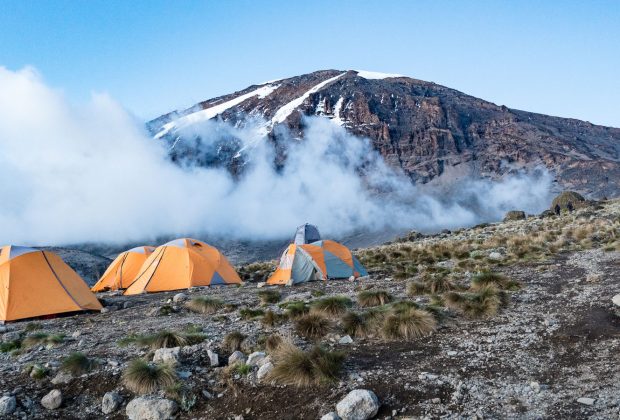
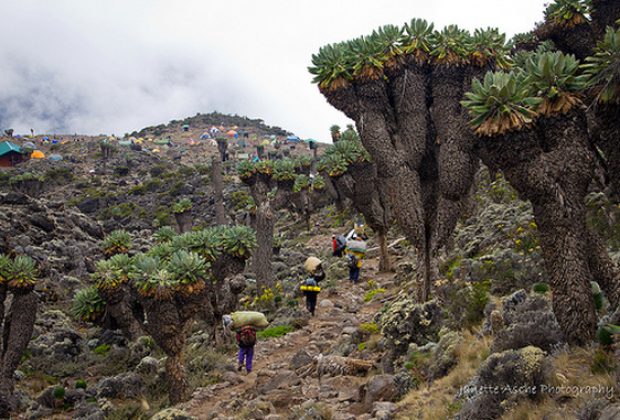
Lemosho is a classic trail that has gained much popularity in recent years. And deservingly so: it offers amazing views, a great acclimatization profile, and some of the highest summit success rates among all routes. Starting on the western slope of Kilimanjaro, the Lemosho route is available in 3 itineraries: 7, 8, and 9 days on the mountain. One of Lemosho’s highlights is the Cathedral Peak – one of the highest points of the Shira Volcano (3872 m). You’ll have a chance to go on an acclimatization hike to Cathedral Peak and enjoy the best views Kilimanjaro has to offer. Another iconic feature of Lemosho are huge alien-looking plants, Dendrosenecio kilimanjari, that are only found on this mountain.
Day 1: Londorossi Gate to Mti Mkubwa (Big Tree) Camp
Set out in vehicles for the long drive to the starting point of the Lemosho Trail, the Londorossi Gate. Approaching the mountain from the west, the Lemosho Route starts in the Afromontane Rainforest, which is the first of four ecological zones you encounter on Kilimanjaro. Here you meet the rest of your crew and set off at a leisurely pace while keeping your eyes peeled for wildlife. Lunch is taken on the trail and camp is reached mid-afternoon.
- Elevation: 2,100 meters (6,890 feet) to 2,650 meters (8,694 feet)
- Distance: 7 km (4.3 miles)
- Hiking Time: 3-4 hours
- Habitat: Rainforest
Day 2: Mti Mkubwa Camp to Shira 1 Camp
From the forested slopes of Lemosho you ascend through a podocarpus and juniper forest and then break out on to a zone of heather and lichen-draped volcanic rock and the Shira Plateau, which used to be Kilimanjaro’s third peak before it collapsed. Lunch is taken on the trail and you arrive in camp mid-afternoon. The view of Kibo (the peak of Kilimanjaro) is breathtaking from this vantage point. Overnight at Shira 1 Camp.
- Elevation: 2,650 meters (8,694 feet) to 3,610 meters (11,810 feet)
- Distance: 8 km (5 miles)
- Hiking Time: 5-6 hours
- Habitat: Moorland
Day 3: Shira 1 Camp to Moir Hut
Crossing the Shira Plateau – one of the highest plateaus on Earth – is one of the most scenic parts of this trip during your 3-4 hour hike across moorland meadows to the lunch point. After lunch you ascend to Moir camp, arriving in the mid afternoon. If you have the energy, a hike in the late afternoon is possible in the surrounding Lent Hills, which makes this an excellent acclimatization opportunity. Overnight at Moir Hut.
- Elevation: 3,610 meters (11,810 feet) to 3,850 meters (12,631 feet)
- Distance: 7 km (4.3 miles)
- Hiking Time: 3-4 hours
- Habitat: Moorland
Day 4: Moir Hut via Lava Tower to Barranco Camp
From Moir you traverse the slopes of Kibo. Here relatively little flora or fauna can survive the extreme temperature ranges and conditions that typify this zone. Lunch is normally taken close to a volcanic rock formation known as the Lava Tower. If you feel very strong there is an optional ascent of the 300-foot-tall Lava Tower before descending down to Barranco camp in the afternoon, passing through the strange yet beautiful ‘Garden of the Senecios’ (giant groundsel) which also features many giant lobelias. The Barranco Valley is one of the prettiest areas of the entire trail. Overnight at Barranco Camp.
- Elevation: 3,850 meters (12,631 feet) to 3,900 meters (12,795 feet)
- Distance: 10 km (6.2 miles)
- Hiking Time: 7-8 hours
- Habitat: Alpine Desert
- Highlights: Acclimatization at Lava Tower (4,630 meters / 15,190 feet)
Day 5: Barranco Camp to Karanga Camp
You now have a relatively short day to reach Karanga Camp, after conquering the intimidating Barranco Wall. Be prepared to use all four limbs as you traverse the wall to the top of the Karanga Valley. From here, follow a path that sojourns through many inclines and declines to Karanga Camp, arriving in the late afternoon. Our selection of Karanga Camp is strategic – significant time at altitude is essential for safe acclimatization. Sunsets here are particularly spectacular with views of the southern glacial valleys and ice fields towering over 3000 feet above you. Overnight at Karanga Camp.
- Elevation: 3,975 meters (13,044 feet) to 3,995 meters (13,106 feet)
- Distance: 5 km (3.1 miles)
- Hiking Time: 4-5 hours
- Habitat: Alpine Desert
- Highlights: Barranco Wall
Day 6: Karanga Camp to Barafu Camp
Today is another half day ascending to Barafu Camp. Once again lunch is taken in this high camp, allowing plenty of time to relax before the summit bid. Desolate alpine desert and, at times, strong winds rip over this camp, yet in the evenings splendid views of Mawenzi peak are the norm. A relatively early dinner is taken before resting for the evening. Overnight at Barafu Camp.
- Elevation: 3,995 meters (13,106 feet) to 4,673 meters (15,331 feet)
- Distance: 4 km (2.5 miles)
- Hiking Time: 3-4 hours
- Habitat: Alpine Desert
Day 7: Barafu Camp to Uhuru Peak to Mweka Camp
Depart just before midnight for the final summit bid. Patience and persistence is the name of game to reach the summit, and this is the coldest, windiest section of your adventure. Most likely by dawn, as the first rays of light start to appear across the Tanzanian landscape, you arrive near the rim at Stella Point, at an altitude of 18,652ft. Here, you are rewarded with the most glorious sunrise you are ever likely to see, appearing over Mawenzi Peak. Ascending via Stella Point affords a relatively short final section to Uhuru Peak, the Roof of Africa! Take as many pictures as you can! After a short celebration at the summit, begin the ebullient trek down. Go slowly and enjoy the wonderful rainforest scenery as you head towards Mweka Camp, arriving before dusk. With every step the air has more and more oxygen so although your legs will be jelly your heart will be light. Overnight Mweka Camp
- Elevation: 4,673 meters (15,331 feet) to 5,895 meters (19,341 feet) to 3,100 meters (10,170 feet)
- Distance: 5 km (3.1 miles) ascent, 12 km (7.5 miles) descent
- Hiking Time: 10-14 hours
- Habitat: Arctic to Moorland
Day 8: Mweka Camp to Mweka Gate
After breakfast, we trek to the Mweka Park Gate, where you will obtain your summit certificates. It might be muddy and damp at lower levels. The use of gaiters and trekking poles will be beneficial. T-shirts and shorts will suffice (keep rain gear and warmer clothing handy). This marks the end of our 8 day Lemosho Route tour
- Elevation: 3,100 meters (10,170 feet) to 1,640 meters (5,380 feet)
- Distance: 10 km (6.2 miles)
- Hiking Time: 3-4 hours
- Habitat: Rainforest
Key Points
- Acclimatization: The 8-day itinerary provides good acclimatization opportunities with gradual elevation gains and time to adjust to the altitude.
- Scenery: The route traverses diverse ecosystems, offering stunning views and varied landscapes, from lush rainforests to alpine deserts and arctic conditions at the summit.
- Difficulty: Moderate to high; the trek requires good physical fitness and stamina.
Preparation Tips
- Physical Fitness: Prepare with cardio exercises, strength training, and hiking to build endurance.
- Gear: Pack for a range of weather conditions, including warm clothing for high altitudes and rain gear for the rainforest sections.
- Health: Stay hydrated, eat well, and listen to your body to manage altitude sickness. Consider taking medication like Diamox for acclimatization, after consulting with your doctor.
This 8-day Lemosho Route itinerary offers a balance of challenge and enjoyment, making it one of the most recommended routes for those aiming to reach the Roof of Africa
- Price Include:
* All transfers* Accommodation
* all trekking fees,
* All meals while on the Mountain
* Guides, Porters, cook salaries and park fees
* Quality Mess tents with table and chairs
* English speaking guide
* Sleeping bags
* Porters salary
• 3 meals in a day
• Mineral drinking water.
Price Exclude:* Tips,
* medical insurance cover
* all trekking personal gears
* alcohol
* all things of personal nature
What is Mount Kilimanjaro?
- Mount Kilimanjaro is the highest peak in Africa, located in Tanzania. It is a dormant volcano and one of the most iconic mountains in the world.
How tall is Mount Kilimanjaro?
- The summit of Mount Kilimanjaro, called Uhuru Peak, stands at an elevation of 5,895 meters (19,341 feet) above sea level.
How long does it take to climb Mount Kilimanjaro?
- The duration of a Kilimanjaro climb varies depending on the route chosen. Most climbs typically range from 5 to 9 days.
What are the different routes up Mount Kilimanjaro?
- There are several routes to the summit of Kilimanjaro, each with its own characteristics and scenery. Popular routes include the Marangu, Machame, Lemosho, Rongai, and Northern Circuit routes.
Is climbing Mount Kilimanjaro difficult?
- Climbing Kilimanjaro is challenging due to its high altitude, but it doesn’t require technical climbing skills. However, climbers should be physically fit and prepared for the rigors of high-altitude trekking.
Do I need a guide to climb Mount Kilimanjaro?
- Yes, it is mandatory to have a registered guide accompany you on your Kilimanjaro climb. Guides are essential for safety, navigation, and providing support throughout the trek.
When is the best time to climb Mount Kilimanjaro?
- The best times for climbing Kilimanjaro are during the dry seasons, which are typically from late June to October and from December to March. These months offer clearer skies and better trekking conditions.
What should I pack for climbing Mount Kilimanjaro?
- Essential items for climbing Kilimanjaro include proper clothing for varying temperatures, sturdy hiking boots, a good quality sleeping bag, trekking poles, personal medications, and other necessary gear as recommended by your tour operator.
What are the risks of climbing Mount Kilimanjaro?
- The main risks of climbing Kilimanjaro include altitude sickness, which can affect anyone regardless of fitness level, as well as other potential hazards such as extreme weather conditions and physical exhaustion.
Do I need to train before climbing Mount Kilimanjaro?
- Yes, it is highly recommended to undergo physical training and preparation before attempting to climb Kilimanjaro. This can include cardiovascular exercises, strength training, and hiking to build endurance and fitness levels.
Per Person $2,980
GROUP $2,480
